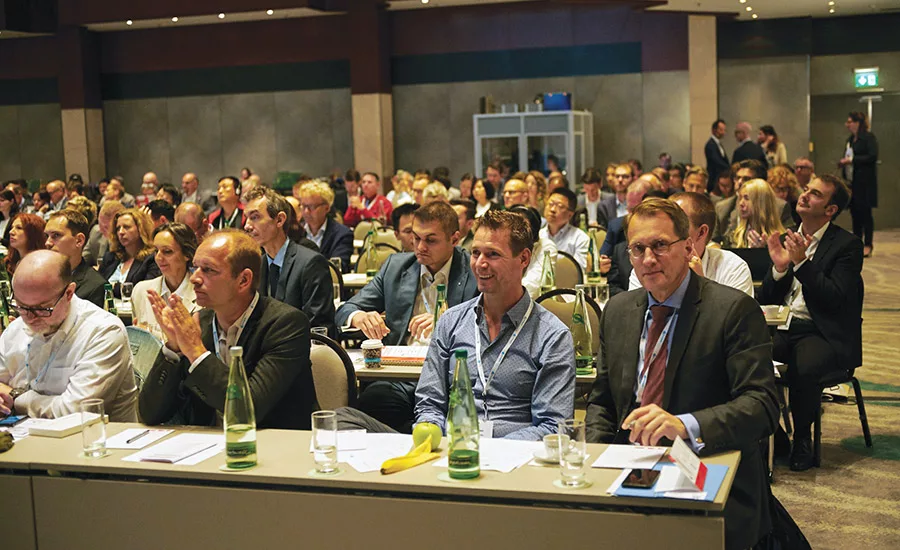Afera First Global Adhesive Tape Summit a Success
The conference drew more than 230 tape-related company delegates, including a significant number of CEOs and heads of R&D, from 15 European countries.

Afera, the European Adhesive Tape Association, reported its first Global Adhesive Tape Summit included a sold-out program of market and technical lectures, a company visit of Neenah Gessner GmbH, and biennial international test method and standards committee meetings. The summit took place June 11-15 in Munich, Germany.
Themed “Relationships and Drivers in the Tape Business: Creating and Leveraging Technology, Markets, Processes, Value and Opportunities,” the event was attended by more than 230 delegates, including a significant number of CEOs and heads of R&D, from 15 European countries, China, India, Israel, Japan, Singapore, Taiwan, the United Arab Emirates, and the U.S. Afera members made up about 71% of the participants; 43 attendees represented Afera member tape manufacturers and 104 were member suppliers involved with raw materials, machines, and packaging.
“The sheer amount of information shared in the lectures and the quality of the papers and speakers probably made this the best business event I have ever experienced,” said Evert Smit, summit host, Afera technical committee chairman and presidential nominee, and head of R&D at Lohmann GmbH & Co. KG. “The strongest idea that I am coming away with is that we are all in this industry together—manufacturers, suppliers, converters. Not only will we have to cooperate and to create together in order to survive, but we are going to have to be more transparent in everything we do, and in many ways, this begins at an event such as the summit.”
Popular Presentations
Participant feedback deemed three of the 28-lecture program presentations as the most popular:
- “Circular Economy: A Way to More Sustainability,” presented by Hermann Onusseit of IVK, the German Adhesives Association. Onusseit discussed the ERPC Monitoring Report 2016 and how adhesives and packaging tapes affect the recycling of paper products. Citing cooperative European industry studies, NGO guidelines and regulatory trends, he conveyed how they should be dimensioned and mechanically stabilized, so that they survive as large particles in the conditions of pulping and allow for mechanical separation by means of punched screens, slot screens, and centrifugal purifiers.
- “Investigation into the Smell of Adhesives,” by Philipp Denk of the Department of Sensory Analytics at the Fraunhofer Institute for Process Engineering and Packaging IVV, and chair of Aroma and Smell Research at Friedrich-Alexander-Universität Erlangen-Nürnberg. Denk explained how the formation pathway, chemical structure and odor quality of 20 compounds in six acrylic adhesives are critical in supporting manufacturers to develop strategies to produce low-odor and low-emission adhesives, and thus positively influence everyday odor exposure.
- “(Semi)-Structural Bonding Tapes Based on Polyurethane Dispersions,” a talk given by Annette Kelsch, R&D team leader of reactive adhesives at Lohmann GmbH & Co. KG. Kelsch shared the outstanding properties of latently reactive polyurethane tapes, including that they: cure within seconds; have a low activation temperature providing for high temperature resistance properties; are applicable on sensitive surfaces; stay flexible and elastic after curing; have high chemical, heat and washing resistance; and are available in individual and pre-shaped die-cuts.
Global Tape Forum and Committee Meetings
On the first day of the summit, Afera hosted the biennial international meeting of the regional industry associations and their test method experts. Nearly 30 delegates from the national/regional adhesive tape associations of China (CATIA, The China Adhesives and Tape Industry Association), Taiwan (TAAT, The Taiwan Regional Association of Adhesive Tape Manufacturers), North America (PSTC, The Pressure Sensitive Tape Council) and Japan (JATMA, The Japanese Adhesive Tapes Manufacturers Association) gathered at the Global Tape Forum (GTF) and Global Test Methods Committee (GTMC)’s 6th set of biennial meetings to work through agendas loaded with standardization issues such as harmonizing test methods (TMs) and guidelines, sharing market statics and trends, comparing environmental legislation and classifying of tape products, identifying world markets not yet organized, and reporting on demand increase initiatives.
“The GTF brings us global players even closer together in sharing common goals for expanding the application of tape and consequently our members’ markets,” said Michael Yang, GTF chairman and CATIA secretary general. “The reason we came to Munich with a particularly large delegation is that we wanted to expand our knowledge and to develop our contacts in the global industry.”
Michel Merkx, incoming GTF vice chairman, PSTC president and general manager at American Biltrite Inc., said, “The PSTC is proud to be part of a forum that believes in and drives harmonization, collaboration and transparency supporting global growth and improvement of our industry, markets/application and customers.”
Of important note was the GTF members’ renewed commitment to “bring content to their objectives,” particularly in the area of exchanging information. The idea is that www.globaltapeforum.com should be a source for each member association of information about top-level market production data and trends, environmental regulation, and meetings and events of the other countries and regions. They also plan to circulate their newsletters and publications.
Market Production Data and Analysis
During the summit, multiple presentations were delivered by delegates from each global region represented in the GTF. Session 1 kicked off with global and national market overviews, most of which were first reviewed in the GTF meeting the day before.
Participants learned that with steady technological progress and improved efficiency and quality, China’s tape industry will maintain an annual growth rate higher than that of GDP, around 7%. Over the next few years, Taiwan expects a relatively slow growth rate of 2% CAGR. Japan makes up less than 10% of the global tape market in sales, which in 2016 were $3.7 billion, and its market volume is slowly shrinking. In Western Europe, adhesive tape production will rise a modest 1.2% annually to 6.3 billion sq m in 2018. ASI
The next GTF and GTMC Meetings will be hosted by JATMA on November 16-19 2020 in Osaka, Japan. For more information, visit www.globaltapeforum.com.
Afera recently announced the launch of its adhesive tape industry Annual Conference, the premier event for the European tape business, taking place October 3-5 in Athens (Vouliagmeni), Greece. Focusing on “Innovation and Digitization in Adhesive Tape Technology” and its impact on suppliers, sales channels, product development, converters, supply chains, business models, technology and the application process, the conference will provide tape industry professionals with the opportunity to interact with tape industry leaders, sales and technology drivers, and future-focused speakers with inside and outside-in perspectives to share.
In Athens, more than 150 participants from Europe and around the globe will meet company delegates from businesses along the entire adhesive tape value chain, including tape manufacturers, suppliers (raw materials, machine and packaging), converters, distributors, research institutions, national tape organizations, and other international counterparts. The working program will consist of 12 lectures over two days. For more information, visit www.aferatapeconference.com.
Looking for a reprint of this article?
From high-res PDFs to custom plaques, order your copy today!






